Tomislavgrad
Tomislavgrad (Serbo-Croatian pronunciation: [tǒmislaʋgrâːd]), also known by its former name Duvno ([dǔːʋno]), is a town and municipality located in Canton 10 of the Federation of Bosnia and Herzegovina, an entity of Bosnia and Herzegovina. It mainly covers an area of the historical and geographical region of Tropolje. As of 2013, it has a population of 33,032 inhabitants.
Tomislavgrad Томиславград Duvno | |
|---|---|
Town and municipality | |
Mijat Tomić Street in Tomislavgrad | |
 Flag 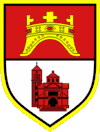 Coat of arms | |
 Tomislavgrad | |
| Coordinates: 43°43′N 17°14′E | |
| Country | Bosnia and Herzegovina |
| Entity | Federation of Bosnia and Herzegovina |
| Canton | Canton 10 |
| Historical region | Tropolje |
| Government | |
| • Mayor | Ivan Vukadin (HDZ BiH) |
| Area | |
| • Land | 967 km2 (373 sq mi) |
| Elevation | 900 m (3,000 ft) |
| Population (2013) | |
| • Total | 31,592 |
| • Density | 33/km2 (90/sq mi) |
| • Town | 5,760 |
| Time zone | UTC+1 (CET) |
| • Summer (DST) | UTC+2 |
| Area code(s) | +387 34 |
| Website | tomislavgrad |
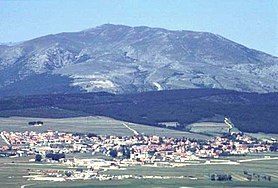
Name
The city name means literally "Tomislav town". The name was changed from Županjac to Tomislavgrad in 1925 by King Alexander I of Yugoslavia in tribute to his son Prince Tomislav and also Tomislav, the first king of the Kingdom of Croatia, who was crowned in the area. The name was changed to Duvno after World War II by Yugoslav communist authorities. In 1990 the name was restored to Tomislavgrad. Still, among inhabitants of Bosnia and Herzegovina, the local residents are often referred as Duvnjaci ("Duvniaks") and the town is often called Duvno. Also, the town is sometimes referred to simply as "Tomislav". The Catholic diocese in that area is still called Mostar-Duvno. During the Roman Empire the town was called Delminium and during the medieval period in Kingdom of Croatia and Kingdom of Bosnia it was called Županjac. Under the Ottoman Empire, it was called Županj-potok and in Austria-Hungary, Županjac.
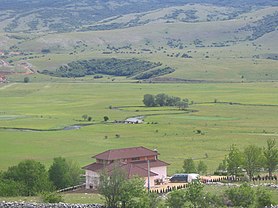
Location
Tomislavgrad is 38 kilometres (24 mi) from the canton seat Livno, 88 kilometres (55 mi) from Mostar, and 162 kilometres (101 mi) from Sarajevo.[1]
Demographics
Population
| Population of settlements – Tomislavgrad municipality | ||||||
|---|---|---|---|---|---|---|
| Settlement | 1961. | 1971. | 1981. | 1991. | 2013. | |
| Total | 33,046 | 33,135 | 30,666 | 30,009 | 33,032 | |
| 1 | Blažuj | 325 | 332 | |||
| 2 | Bobara | 236 | ||||
| 3 | Bogdašić | 404 | 346 | |||
| 4 | Borčani | 759 | 828 | |||
| 5 | Bukova Gora | 205 | 311 | |||
| 6 | Bukovica | 962 | 892 | |||
| 7 | Ćavarov Stan | 66 | 343 | |||
| 8 | Cebara | 139 | 222 | |||
| 9 | Crvenice | 773 | 997 | |||
| 10 | Dobrići | 481 | 446 | |||
| 11 | Donji Brišnik | 866 | 790 | |||
| 12 | Eminovo Selo | 674 | 595 | |||
| 13 | Galečić | 280 | 279 | |||
| 14 | Grabovica | 350 | 543 | |||
| 15 | Jošanica | 216 | 214 | |||
| 16 | Kazaginac | 301 | 277 | |||
| 17 | Kolo | 636 | 998 | |||
| 18 | Kongora | 866 | 862 | |||
| 19 | Korita | 179 | 200 | |||
| 20 | Kovači | 366 | 352 | |||
| 21 | Kuk | 207 | 232 | |||
| 22 | Letka | 701 | 551 | |||
| 23 | Lipa | 349 | 276 | |||
| 24 | Liskovača | 201 | 248 | |||
| 25 | Lug | 266 | 243 | |||
| 26 | Mandino Selo | 453 | 449 | |||
| 27 | Mesihovina | 964 | 978 | |||
| 28 | Mijakovo Polje | 184 | 232 | |||
| 29 | Mokronoge | 550 | 548 | |||
| 30 | Mrkodol | 1,091 | 999 | |||
| 31 | Omerovići | 321 | 242 | |||
| 32 | Omolje | 670 | 656 | |||
| 33 | Oplećani | 424 | 376 | |||
| 34 | Pasić | 150 | 250 | |||
| 35 | Prisoje | 1,150 | 1,107 | |||
| 36 | Rašeljke | 430 | 383 | |||
| 37 | Roško Polje | 1,158 | 1,000 | |||
| 38 | Sarajlije | 413 | 460 | |||
| 39 | Seonica | 395 | 421 | |||
| 40 | Srđani | 284 | 325 | |||
| 41 | Stipanjići | 1,249 | 1,167 | |||
| 42 | Šuica | 1,446 | 1,758 | |||
| 43 | Tomislavgrad | 1,986 | 3,265 | 4,231 | 5,012 | 5,760 |
| 44 | Vedašić | 658 | 547 | |||
| 45 | Vinica | 412 | 718 | |||
| 46 | Vojkovići | 337 | 288 | |||
| 47 | Vrilo | 169 | 349 | |||
Ethnic composition
| Ethnic composition – Tomislavgrad town | |||||||
|---|---|---|---|---|---|---|---|
| 2013. | 1991. | 1981. | 1971. | 1961. | |||
| Total | 5,760 (100,0%) | 5,012 (100,0%) | 4,231 (100,0%) | 3,265 (100,0%) | 1,986 (100,0%) | ||
| Croats | 4,575 (81,89%) | 3,164 (63,13%) | 2,528 (59,75%) | 1,809 (55,41%) | 1,032 (51,96%) | ||
| Bosniaks | 955 (17,09%) | 1,472 (29,37%) | 1,248 (29,50%) | 1,167 (35,74%) | 637 (32,07%) | ||
| Unaffiliated | 21 (0,376%) | ||||||
| Serbs | 16 (0,286%) | 219 (4,370%) | 214 (5,058%) | 241 (7,381%) | 246 (12,39%) | ||
| Albanians | 11 (0,197%) | 25 (0,591%) | 4 (0,123%) | 4 (0,201%) | |||
| Others | 6 (0,107%) | 62 (1,237%) | 13 (0,307%) | 22 (0,674%) | 7 (0,352%) | ||
| Montenegrins | 2 (0,036%) | 2 (0,047%) | 6 (0,184%) | 5 (0,252%) | |||
| Unknown | 1 (0,018%) | ||||||
| Yugoslavs | 95 (1,895%) | 201 (4,751%) | 16 (0,490%) | 55 (2,769%) | |||
| Ethnic composition – Tomislavgrad municipality | |||||||
|---|---|---|---|---|---|---|---|
| 2013. | 1991. | 1981. | 1971. | 1961. | |||
| Total | 33,032 (100,0%) | 30,009 (100,0%) | 30,666 (100,0%) | 33,135 (100,0%) | 33,046 (100,0%) | ||
| Croats | 29,006 (91,81%) | 25,976 (86,56%) | 26,712 (87,11%) | 29,272 (88,34%) | 29,704 (89,89%) | ||
| Bosniaks | 2,472 (7,824%) | 3,148 (10,49%) | 2,895 (9,440%) | 2,760 (8,330%) | 1,828 (5,532%) | ||
| Unknown | 40 (0,127%) | ||||||
| Unaffiliated | 27 (0,085%) | ||||||
| Serbs | 22 (0,070%) | 576 (1,919%) | 671 (2,188%) | 970 (2,927%) | 1,239 (3,749%) | ||
| Albanians | 11 (0,035%) | 25 (0,082%) | 5 (0,015%) | 6 (0,018%) | |||
| Others | 11 (0,035%) | 202 (0,673%) | 69 (0,225%) | 65 (0,196%) | 72 (0,218%) | ||
| Montenegrins | 2 (0,006%) | 9 (0,029%) | 9 (0,027%) | 14 (0,042%) | |||
| Slovenes | 1 (0,003%) | 3 (0,010%) | 8 (0,024%) | 4 (0,012%) | |||
| Yugoslavs | 107 (0,357%) | 280 (0,913%) | 40 (0,121%) | 177 (0,536%) | |||
| Macedonians | 2 (0,007%) | 6 (0,018%) | 2 (0,006%) | ||||
History
Ancient times
Illyrian time
The area has been inhabited by Illyrian tribe of Dalmatae[2] and Delminium was a town established by them in nowadays Tomislavgrad.[3] Delminium was situated on the location of today's Roman Catholic basilica, named after the first Croatian saint, Nikola Tavelić.
The area of Tomislavgrad has been populated in 4000 BC - 2400 BC, even before Illyrians arrived, and from that time only polished stone axes remained as proof that someone was here.[4] Bronze Age (1800 BC - 800 BC) also left few marks in Tomislavgrad. Archeological collection of monastery in Široki Brijeg had few items founded on area of Tomislavgrad from Bronze Age: 34 bronze sickles, 3 axes and 2 spears. Those items were found in Stipanjići and Lug near Tomislavgrad. Those items were given to Archeological collection "fra Mijo Čuić and fra Stjepan Naletilić". Later, Fr Vojislav Mikulić found a bronze axe in Letka which he gave to those collections. Unfortunately, collection was destroyed in fire at the end of World War II. Only one sickle and axe survived the tragedy.[4] However, this collection says that population of Tomislavgrad at the time worked in primary sector, they were cattlemen, farmers and warriors.[4]
Unlike their unnamed predecessors, Illyrians left material proofs from their time. On the slopes of the mountains which circle Tomislavgrad, Illyrians built 36 fortifications. These forts served as watchtower or forts against the enemy. There are also many graves of Illyrians which means that they cared about their dead. Same as forts, graves are dating from Bronze and Iron Age to Roman conquest of Delminium (Tomislavgrad). In the graves of dead Illyrians, jewellery and items which the dead used, were found.[4]
Another inhabitants, except Illyrians, were Celts. They brought higher culture, crafts and most importantly better arms.[5] But soon, Celts have been assimilated as Illyrians, since there was only small number of them.[5]
As Romans conquered territory of Illyrian tribe Ardiaei, and so, Delmataes and their tribal union were last bastion of Illyrian freedom. The Dalmatae attacked Roman wards near Neretva, Greek merchant towns and the Roman friendly Illyrian tribe Daors. The Illyrians upgraded their settlements into strong forts and surrounded their capital with wreath of smaller forts.[5] It is assumed that, during that time, 5,000 Dalmatae lived in Delminium.[5]
In 167 BC Illyrian forts could not stop Roman legions and Rome conquered the entire Adriatic coast south of Neretva; the state of the Ardieaei was also destroyed. The first conflict between the Dalmatae and Rome started in 156 BC. The consuls Gaius Marcius Figulus, then Publius Cornelius Scipio Nasica Corculum conquered and destroyed Delminium; the latter received a triumph in Rome for this victory. Reports of writers during that time say that Delminium was a "large city", almost inaccessible and impregnable. Romans shot lighted arrows at wooden houses, which then burned the city.[5] After various rebellions led by Dalmatae and three wars with Rome, their land was lastly conquered for good in 9 AD.
Roman time
After Roman conquest of Delminium, they started building roads and bridges. Roads that led to mainland of Balkans from Adriatic coast in Salona (Solin) and Narona (Vid near Metković) crossed in Delminium (Tomislavgrad). Remains of those and other Roman roads are still in existence.[4] Romans introduced their culture, language, legislation and religion. For next 400 years Tomislavgrad was in peace.
After the Romans defeated Dalmatae, Tomislavgrad was almost abandoned. There was also, for some period, a military crew of Romans stationed there to keep Illyrians under control.[4] Romans started to rebuild Delminium in 18 and 19 AD in time of emperor Tiberius.[4] During that time the center of the city was built, a Roman forum. This forum was built on possession of present-day Nikola Tavelić basilica.[4]
In 1896 Fra Anđeo Nuć discovered various sculptures of Roman pagan deities, fragments of pagan sarcophagi, and fragments of columns of medieval Christian church. From all those discoveries, most prominent are two votive monuments and altars dedicated to goddess Diana, one altar dedicated to native Illyrian god Armatus and one votive plate dedicated to goddess Libera. Later, relief of goddess Diana was also found and one relief of Diana and Silvanus together. Also, new pagan altars, fragments of sarcophagi, clay pottery, parts of columns, and various other findings from Roman and early medieval age were found. This led to conclusion that on place of present-day Catholic graveyard "Karaula" (which was previously an Ottoman military border post and guardhouse) was Roman and Illyrian pagan sanctuary and graveyard.[4]
Middle Ages
Croats settled this area in the 7th century, and the area was renamed to Županjac. The area around Tomislavgrad was important in Croatian history in Croatian early Middle Ages. According to the Cronicle of Doclea priest the most important event from this period was the first assembly of Croatia in the year 753. The first Croatian court was made at the mountain Lib when Croats have arrived to Duvno area. In that court duke Budimir has hosted the deputy of Pope Stephen II and Byzantine Emperor Constantine V.
There were made the prepairement for the Great assembly of kingdom and Church. At that assembly the country was divided on the three big regions, divided on more autonomous provinces, whose borders were taken from the Roman times. It has been determined the administration, taxes and justice system. It is a commonly accepted theory that coronation assembly of King Tomislav was placed in the 925 at that area.
The Duvno field with the city of Županjac was in the possession of Croatian kings till the 2nd half of the 13th century when it became the possession of noble family Šubić. At the end of 13th and beginning of 14th century, the Šubić family, with approval from the Pope Boniface VIII, established three dioceses on the territory of the Archdiocese of Split, the Diocese of Šibenik, the Diocese of Makarska and the Diocese of Duvno. The motive for the establishment of those dioceses was to halt the spread of the Bosnian Church and strengthening of Šubićs' influence in the area. The seat of the Diocese of Duvno was the Church of Saint John the Baptist, located in the town of Rog, near the present-day Roško Polje. The bishops of Duvno served mostly as assistants to the archbishop of Split or were only titular bishops.
Until 1320s, Duvno was part of the Kingdom of Croatia, when Stephen II, Ban of Bosnia took the land from Šubićs and incorporated it in the Banate of Bosnia. Duvno became a part of the Western Regions, a province of the Banate of Bosnia, together with Livno and Glamoč. However, the population of the Western Regions didn't identify with the Bosnian Kingdom. After King Tvrtko gave in the territory of Zachlumia westwards from the Neretva river to the Hungarian and Croatian King Louis I in 1357, Duvno became the southwesternmost part of his realm towards the Kingdom of Croatia.
A struggle broke out in the village of Kolo, in Duvno, in 1374, due to a division over loyalty between the Bosnian and Croatian-Hungarian King. For this reason, Tvrtko took over the village and gave it to the Semković family from Usora, and their ownership over the village was confirmed by King Dabiša in 1395. In 1404, King Ostoja gave Duvno and Glamoč to Duke Pavle Klešić. In 1444 or earlier, Duvno became a possession of Stjepan Vukčić Kosača, the duke of the Duchy of Saint Sava.
Ottoman Empire
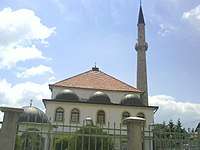
Duvno was conquered by the Ottomans in 1477, who established the Nahiyah of Duvno, and incorporated it to the Sanjak of Herzegovina. It became part of the Kadiluk of Foča. Somewhere before 1519, Duvno was incorporated to the Kadiluk of Mostar. For a short period between 1528 and 1537, Duvno was part of the Sanjak of Bosnia, and during the same period it was part of the Kadiluk of Neretva. It was again incorporated to the Sanjak of Herzegovina and the Kadiluk of Mostar.
In the middle 16th century, the Ottomans founded a qasaba Županj-Potok. In 1576 Duvno became part of the Kadiluk of Imotski, and it became a kadiluk on its own before 1633. In the second half of the 17th century, Duvno became a part of the Sanjak of Klis, however, it was soon returned to the Herzegovinian Sanjak. At the beginning of the 18th century, Duvno became a captaincy, with the seat in the town of Rog. However, due to security reasons, the seat was transferred in 1711 to the Seddi Cedid, a fort built in Županj-Potok.
Hamdija Kreševljaković mentions a borough named Duvno at the end of the 17th century and also states that this borough became a kaza in the first years of the 18th century. In the middle of the 17th century Evliya Çelebi, a famous Turkish travel writer, stated that Duvno "looks like a paradise garden, it is part of the Sanjak of Klis and has four hundred of houses and one imposing mosque, many masjids, one inn, one hamam and ten shops." Duvno remained under the Ottoman rule until 1878 when Austria-Hungary occupied Bosnia and Herzegovina after the Berlin Congress.
Austria-Hungary
Kingdom of Yugoslavia
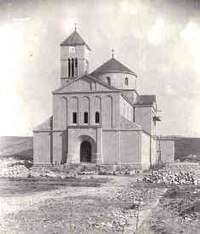
In 1925, Duvno was renamed Tomislavgrad for the first croatian king Tomislav of Croatia and for the prince of the kingdom of Yougoslavia Tomislav Karađorđević.
Contemporary
Duvno was renamed back to Tomislavgrad after the Bosnian War.
Settlements
• Baljci • Blažuj • Bogdašić • Borčani • Bukova Gora • Bukovica • Cebara • Crvenice • Ćavarov Stan • Dobrići • Donji Brišnik • Eminovo Selo • Galečić • Gornja Prisika • Gornji Brišnik • Grabovica • Jošanica • Kazaginac • Kolo • Kongora • Korita • Kovači • Krnjin • Kuk • Letka • Lipa • Liskovača • Lug • Mandino Selo • Mesihovina • Mijakovo Polje • Mokronoge • Mrkodol • Omerovići • Omolje • Oplećani • Pasić • Podgaj • Prisoje • Radoši • Rašćani • Rašeljke • Raško Polje • Renići • Rošnjače • Sarajlije • Seonica • Srđani • Stipanjići • Šuica • Tomislavgrad • Vedašić • Vinica • Vojkovići • Vranjače • Vrilo • Zaljiće • Zaljut • Zidine
Economy
Tomislavgrad today is in a very hard economic situation. Many people emigrated from it in the 1960s and 1970s, but mostly during war in the 1990s. Most went to Croatia (mostly Zagreb), Western Europe (Germany), and Australia. Among the companies active in the city there are couple big companies as "Kapis Tomislavgrad", mall "prodex" and some transport and construction companies.
Monuments and culture
In downtown Tomislavgrad, there is a huge monument in tribute of King Tomislav made by sculptor Vinko Bagarić from Zagreb and installed in the 1990s after the war in Bosnia and Herzegovina.
References
- The Cambridge Ancient History Vol. 11: The High Empire, AD 70-192 by Peter Rathbone, page 597, "... One such place was Delminium, from which the Illyrian Delmatae took their name, attacked more than once by Roman consuls ..."
- Wilkes, J. J. The Illyrians, 1992; ISBN 0-631-19807-5, pg 188, "... after whom the Roman province Dalmatia was named, their own name being derived from their principal settlement Delminium near Duvno. Beyond the Dinara, Delmatae occupied the plains of Livno, Glamoc, and Duvno, ..."
- (in Croatian) Bagarić, Ivo. Duvno: Povijest župa duvanjskog samostana. Sveta baština. 1989
- (in Croatian) Bagarić, Ivo. Duvno - Short Monograph. Župni ured sv. Franje Asiškog, Bukovica. 1980.
External links
| Wikimedia Commons has media related to Tomislavgrad Municipality. |
- "Općina Tomislavgrad". Tomislavgrad.gov.ba. 2016-02-29. Retrieved 2016-03-04.
- "バイクの免許を取ろう |". Tomislavgrad-online.com. 2015-09-25. Retrieved 2016-03-04.
- "Početna". Tomislavcity.com. Retrieved 2016-03-04.